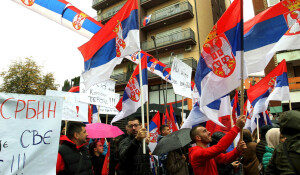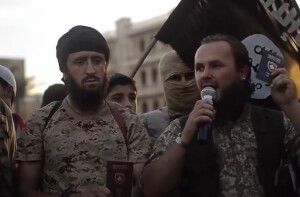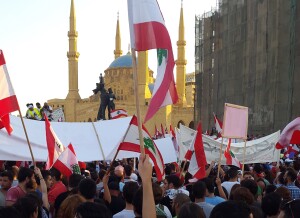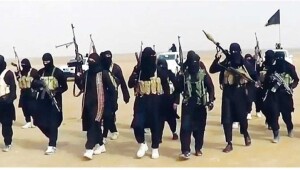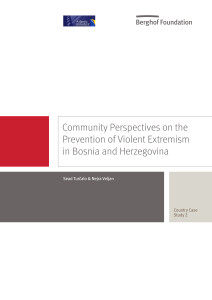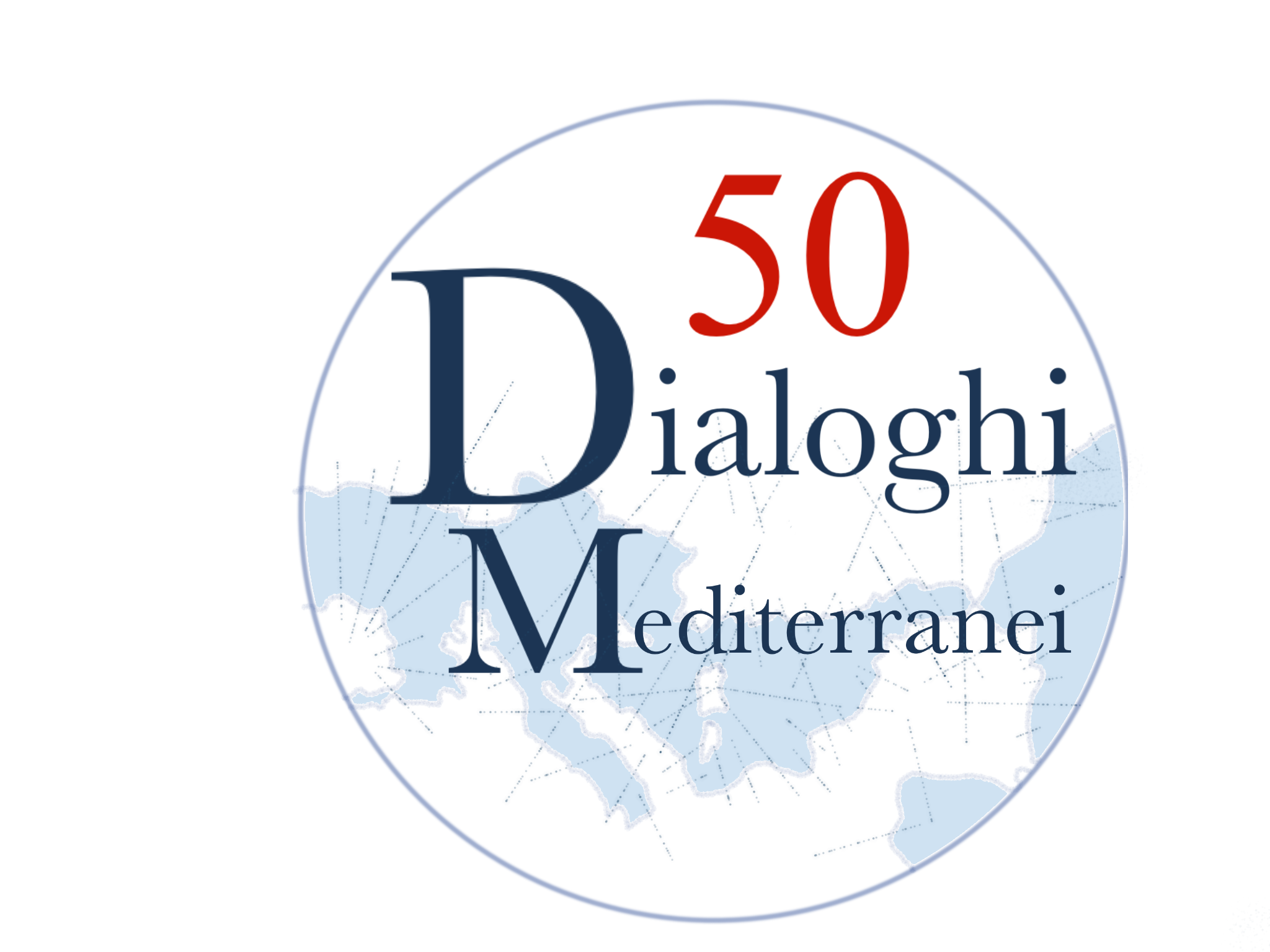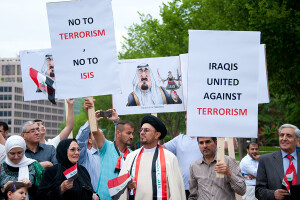
Manifestanti iracheni che protestavano contro l’ISIS davanti alla Casa Bianca a Washington, DC, nel 2014 (ph. Rena Schild/Shutterstock)
di Marie Kortam [*]
Multiple factors and drivers enabled, fueled and/or shaped violent extremism. This phenomenon operates in a particular country context at macro, meso and micro levels (Ellis and Abdi 2017). It questions the relationship of the individual to and between institutions – the family, school, religion, politics, associations, society, the state, justice, etc. in this relation, individuals undertake a voluntary and radical rupture of the existing social contract. They are seeking a new community link and a new cause for commitment.
As a social phenomenon, violent extremism reveals a questioning of the relationship that individuals have with the traditional instances of socialisation that are supposed to frame and standardise the community of citizens, protect individuals, and create the conditions necessary for their development and fulfilment. It is in this sense that the public authorities are doubly called upon, firstly, to rebuild the bonds of trust that must exist in a political community; secondly, to promote/reinvent the sense of civic engagement in individuals – replacing the commitment to an ideology of violence and exclusion. Fighting violent extremism by rebuilding citizens’ trust in their institutions in the form of civic engagement requires political leadership, education, frameworks and mechanisms that make it possible and concrete. This process is more complicated in a sectarian-based system where each community has its own privileges, in addition to its social and religious institutions, such as Bosnia and Herzegovinia (BiH), Serbia, Iraq, in the case of our study, or even legal ones, such as Lebanon. This complication appears, also, in a republican system with a high rate of violent extremism, such as Tunisia.
While violent extremism in the Western Balkans (WB) and Middle East and North Africa (MENA) region has already been the subject of several studies, the interaction between states and religious institutions and the shift towards violent extremism or its prevention has not yet been analysed. This baseline study will focus on drivers related to the interaction between state and religious leaders and institutions. It aims to understand interactions between state and religious formal and informal institutions and actors, as a driver of community vulnerability to violent extremism in the WB and MENA by summarizing different case study. It explores various drivers of violent extremism by assessing the role of (or absence/lacunas/dysfunctions of) state and religious authority figures.
The case of Serbia
Serbia yet struggles with legacies of wars, but also of international isolation during the 1990s and late democratic and economic transition that started in 2000 after the fall of Milosevic. Conflicting historical narratives, competitive victimisation, and collective grievances combined with the poor economic situation, widespread corruption, and malfunctioning of state institutions that fuel ethnoreligious polarisation are the main drivers of the community vulnerability to radicalisation and extremism (Mandaville, Nozell 2017).
The «Republic of Serbia is a state of Serbian people and all citizens who live in it, based on the rule of law and social justice, principles of civil democracy, human and minority rights and freedoms, and commitment to European principles and values» (Serbian Constitution, article 1) [1]. Both Albanians and Bosniak minorities and Serbian majority consider themselves victims of injustice; on the other hand, Serbian youth is convinced that minorities enjoy greater rights than the majority. Lack of trust in governance contributed in shifting from one form of extremism, either far right or Islamist, to cumulative extremism using it «as a country-specific driver of Islamist extremism» (Petrovic and Stakic 2018: 7). This lack of trust in institutions is closely connected to low interpersonal trust in the Serbian society. The division of the Islamic Community attracted dissatisfied believers who created the impression among Muslims that Serbian authority is anti-Muslim (Petrovic and Stakic 2018).
A 2017 survey showed that 41% of Bosnians are primarily concerned with corruption and crime, and 27% with poor governance. In addition, they have the least trust in state institutions and religious institutions are the most trusted organisations among them. This illustrates that corruption has penetrated Serbia’s society and is a daily life experience in public administration, education, and healthcare.
The identity problem appeared in the light of dysfunctional institutions where a survey from 2016 showed that 87% of Sandžak youth are highly religious and recognised their affiliation to the Islamic world (Ilic, 2016). Poor governance allowed the younger generations to accept radicalisation and violent extremism where poor quality education and lack of critical thinking were the main drives. Lack of political will to manage job opportunities and to incubate the youth widened the gap with the state institutions.
All those aspects are more visible and registered in the territory of Sandžak. Where the absence of the State led to marginalization in the region of Sandžak. Sandžak is an internal region of the country with a majority of Muslims (over 50%). Islamist extremism is mainly connected to them. The conflicts and tensions in the 1990s in Sandžak led to the establishment of the Independent Government of Sandžak and resulted in the complete isolation of the region (Corovic 2017). However, the region did not experience any armed conflicts; it was an indication of political violence and suppression (Perry 2019). Through isolating the Sandžak region, the Muslim community experienced religious and political polarisation that led to political instability and radicalisation of the population. Sandžak is one of the least economically developed regions in Serbia. Sandžak has a very young population (over 50% is younger than 30) with high unemployment (around 50%) and poverty rate, it has a serious infrastructure and investment problems (Kisić 2015). Those unsolved economic problems influenced the population of Sandžak lack of trust in state institutions that increased the problem of identity and support for local government. In addition to poor quality education and lack of critical thinking, grievances were exploited by extremist groups (Petrovic and Stakic 2018).
As well, the political division in the Muslim population in Serbia is directly affected by the division of the Islamic community into two competing organisations: Islamic Community of Serbia (ICoS) and Islamic Community in Serbia (ICiS). A new vulnerable driver in the Muslim population towards radicalisation and extremism occurred due to the rise of political and religious division in Sandžak, which allowed the emergence of external fundamentalist influences. In Serbia, the division of the Islamic community succeeded in promoting the new Serbian Islamic community in Belgrade led by Mufti Hamdija Jusufspahic and was considered a political tool by the Sandžak elite. On the other hand, the Bosniak leader from Sandžak, reacted accordingly, and founded the Islamic Community in Sandžak nominating Mufti Muamer Zukorlic as the head. This is to illustrate that by dividing the Islamic Community, new religious communities and clerics emerged and gained responsibility and had a resilient impact on the communities. Belgrade-based Islamic Community was identified as the only legitimate community according to a new Law and Religious Communities created in 2006. ICiS relishes the loyalty for around 250 mosques in Serbia (Perry 2019, Kisie 2015).
Moreover, ICoS is represented in all major Serbian cities in a juridical structure; it is divided into regional (muftiate and meshihat), municipal (majilis), and local administrative (jamaat).[2] This implied that religious institutions have advantages over state institutions towards the ideology of Islamist extremism when jihadists arrived in Sandžak to participate in the Bosnian war, with students who studied in Islamic Universities in the Middle East. Religious agendas began to appear starting from organizing camps with military training for young Muslims when Salafis/Wahhabis became more visible and influential (Kladničanin 2013, Ćorović 2017).
Similarly, financial support to Salafis in Sandžak increased through Al-Furqan and Tawhid mosques to facilitate the spread of radical Islam to increase the number of youths in joining ISIS (Ćorović 2017). Unemployment, lower education, poverty, and identity issues facilitated the recruitment process by targeting the younger population to join ISIS and Salafi organisations. According to several surveys, Bosniaks, Albanians, and population in Sandžak declared themselves true believers that accept all the teachings of their fate (Ilić 2016). Therefore, the control of religion in Sandžak launched a more conservative Islam and the whole region in Western Balkan became more moderate and flexible, a Turkish Style Islam (Perry 2019).
The case of Bosnia and Herzegovina
The particular vulnerability of today’s (multi-confessional and multicultural) society of BiH is the product of the war waged against Bosnia and Herzegovina in the period 1992-1995. Moreover, war remnants still burden mutual interactions making the entire society «especially vulnerable to ethno-nationalism, political radicalism, and ideological extremism» (Turčalo and Veljan 2018: 2).
The interaction between the state institutions and the religious communities is overloaded by ethno-political privacy, fragility and complexity of state institutions, which is often visible in the superficial support of stakeholders. The constitution declares, «Bosnia and Herzegovina shall be a democratic state, which shall operate under the rule of law and with free and democratic elections» (Bosnia and Herzegovina Constitution, article 2)[3]. The constitution does not specifically mention the representation of religious communities, though the peoples (Serbs, Croats, and Bosniaks) registered in the constitution belongs to specific religions [4].
This was well illustrated through the empowering of the Rule of Law on Freedom of Religion and Legal Position of Churches. Allocations through the Public Interest Advocacy Center revealed, in 2015, a total budget of 5.1 million euros for financing traditional religious communities. The Law modified the legal status of religious communities and ensured equal rights to all religious communities [5]. It visualized that churches and religious communities may issue agreements with the Presidency of BiH, the Council of Ministers of BiH or entity governments to regulate their matters. This shows a clear advantage for religious institutions over state institutions. Despite the rights given to the religious institutions and communities, non-governmental organisation revealed discrimination with respect to religious education and the construction of new religious buildings. This Law increased the fragility of the state institutions and weakened its authority over its territory.
Despite the Dayton peace agreement signed in 1995, BiH experienced the absence of the state, in terms of dividing the state into two entities, the Federation of Bosnia and Herzegovina and the Republic of Srpska. Instead of acting with social cohesion, the three primary ethnic communities competed for power and further fragmentation took place on the subnational level that divided the Federation of BiH into 10 cantons. This action raised the problem of identity and belonging. Bosniaks, Croats, and Serbs [6] are considered to belong to the constitution while all other citizens are categorized as ‘others’. In addition, ethnic control of the state institutions from the constituent peoples increased the tensions and the feeling of discrimination and injustice between the different communities in BiH (Beridan, Smajić and Turčalo 2018).
Polarisation of the three ethnic (religious) communities highlighted the lack of mutual trust and inability to resolve these problems institutionally. The decentralization structure in the police and security sector in which 16 police agencies are scattered between state, entities, and cantons weakened the sense of belonging and the capacity to combat corruption and crime. It, also, weakened the judicial institutions and the ability to implement the rule of law (Gordana 2020).
In this conflictual situation, extremists Islamic and Christian’s groups emerge. The first one is due to the arrival of Salafis to BiH during the war (1992–1995) financed by Islamic charities. This was the main causes of the expansion of the informal religious groups or communities. In addition, the Serbian Orthodox Church claims that, the Zealots are the most belligerent and exclusive, they «fight for the purity of the Orthodox faith» [7].
The case of Lebanon
Lebanon has similar vulnerable factors, which is the weakness of the state institutions, represented in the official constitution, as vulnerable drivers, which gives the right for the religious institutions to practice their role without intervention. Article 19 states in specific terms: «The officially recognised heads of religious communities have the right to refer to this Council laws relating to personal status, the freedom of belief and religious practice, and the freedom of religious education» [8].
Tax exemption for the religious institutions is considered a key factor to vulnerability, in addition to receiving grants to their institutions and personnel (Al-Haddad 2015). However, the general budget annually witnesses sectarian allocations that exceed more than 28 billion Lebanese pounds in 2012 (Al-Haddad 2015). It is donated in terms of salaries, wages, allocations, management, supplies, support, family benefits, social protection, equipment, and office building maintenance, to the Fatwa and the Sharia courts, Supreme Islamic Sharia Council (Sunni), the Supreme Islamic Shia Council, Ja’fari Sharia courts, Sheikh Aql of the Unitarian Druze Community, the Druze religious courts, the Confessional Council of the Unitarian Druze Community. Similarly, the Christian spiritual courts’ budget is taken from the budget of the Ministry of Justice.
These religious institutions enjoy special treatment in terms of austerity policies. They are not subjected to any decrease in their allocations and their revenues collected from religious community group members, which «worth millions of dollars», do not undergo auditing. They are not monitored and excluded from paying taxes, instead, their health, social, and cultural care budget is discounted from the ministries of health, education and cultural budgets.
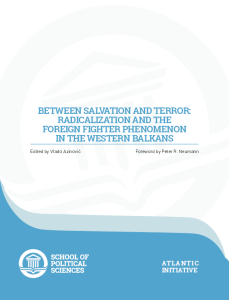 Political interests shape the electoral religious and legislative council leadership. The selection of the religious leaders is closely affiliated with the political elite with their respective communities. The parliament, and the Islamic religious council, House of Fatwa, approved that their internal regulations and religious courts be placed under the mandate of the presidency of the Council of Ministers. The official narrative of the state that declares «Lebanon is the final homeland for all its citizens» and the need to «adhere to mutual coexistence and civilian peace» [9], has been consistently adopted by the religious elite. Thus, religious institutions have always used the discourse of religious literature in mobilise the society during each social upheaval to prevent any constitutional implementations. Religious institutions have always influenced government policy. For example, in an attempt to neutralize the sectarian system that took place during the 1975–1990 civil war, and 1958 crises when Maronite Patriarch Boulos Meouchi agreed on the alliance with the Muslim Leftists against the president Camille Chamoun. Additional attempts to protect the sectarian system were made in March 2011 and in May 2016 when the Maronite Patriarch Bechara Al-Rai challenged the traditional orientation within the Patriarchate. It mobilised the Christian political leaders against the presence of the Syrian army in Lebanon during the Lebanese civil war that ended in 2005 (YaLibnan 2016|). Moreover, Muhammad Rashid Qabbani (Sunni Grand Mufti) overstepped the Sunni consensus in 2012, which is against Hezbollah and the Syrian regime, by meeting with the Iranian ambassador (The Daily Star Newspaper 2010) and Hezbollah representatives (NOW Lebanon 2011). Those religious leaders behave as supra-state actors to defend their positions in the sectarian system.
Political interests shape the electoral religious and legislative council leadership. The selection of the religious leaders is closely affiliated with the political elite with their respective communities. The parliament, and the Islamic religious council, House of Fatwa, approved that their internal regulations and religious courts be placed under the mandate of the presidency of the Council of Ministers. The official narrative of the state that declares «Lebanon is the final homeland for all its citizens» and the need to «adhere to mutual coexistence and civilian peace» [9], has been consistently adopted by the religious elite. Thus, religious institutions have always used the discourse of religious literature in mobilise the society during each social upheaval to prevent any constitutional implementations. Religious institutions have always influenced government policy. For example, in an attempt to neutralize the sectarian system that took place during the 1975–1990 civil war, and 1958 crises when Maronite Patriarch Boulos Meouchi agreed on the alliance with the Muslim Leftists against the president Camille Chamoun. Additional attempts to protect the sectarian system were made in March 2011 and in May 2016 when the Maronite Patriarch Bechara Al-Rai challenged the traditional orientation within the Patriarchate. It mobilised the Christian political leaders against the presence of the Syrian army in Lebanon during the Lebanese civil war that ended in 2005 (YaLibnan 2016|). Moreover, Muhammad Rashid Qabbani (Sunni Grand Mufti) overstepped the Sunni consensus in 2012, which is against Hezbollah and the Syrian regime, by meeting with the Iranian ambassador (The Daily Star Newspaper 2010) and Hezbollah representatives (NOW Lebanon 2011). Those religious leaders behave as supra-state actors to defend their positions in the sectarian system.
The confessional power sharing constitution calls for collaboration between the state and formal religious institutions that failed to promote a new constitution to change the national context. Political and religious polarisation is considered the main vulnerability driver in Lebanon that affects the political structure directly. This led to accepting external authorities to designate the head of Dar El Fatwa. For example, Muhammad Rashid Qabbani gained recognition by Syrian President Hafez Al-Assad. Abdul Latif Derian was selected through a bilateral agreement between Saudi Arabia and Egypt in 2014 (Lefèvre 2015). On the other hand, the Druze community shared the same fate; the Syrian regime had the authority in appointing Sheikh Al-Aql to counterbalance the leadership of Walid Joumblatt. Instrumentalisation and politicization continued on this level, religious interference from the Grand Mufti Qabbani participated in nominating the former president of the council of Prime Minister Najib Mikati in 2011. In addition, religious leaders were involved in the incidents that were portrayed as violent extremism acts, according to Radwan El-Sayyed (2018).
The merging of the boundaries between the state institution and formal religious institutions broadened the gap between these establishments and their confessional groups. The adoption of the securitized approach and the instrumentalisation of the involvement of religious leaders in countering sect-based strains and violent extremism manifestations, has impacted the public confidence in the standing of the religious leadership. According to Radwan El-Sayyed, a number of religious leaders were involved in data and intelligence gathering in the aftermath of incidents that were dubbed as violent extremism acts in Lebanon, particularly after 2011. Subsequent to several rounds of violent clashes between Sunnis in Bab Al Tabbeneh and Alawites in Jabal Mohsen in Tripoli. With the addition of clashes between Sunni groups armed fighters led by Sheikh Ahmad Al-Assir and Hezbollah forces in Saida. the persistence of the detainees in these incidents were yet to be placed on trial. Demonstrating a victimisation discourse of what is assumed as grave injustices towards Sunni groups by the state. Despite the presence of high-ranked Sunni representation in key law and order positions, such a union between the official political and religious domains was perceived by a number of Sunni circles as an additional layer of structural oppression.
The fragility of the state institutions led to accepting the equation that formal religious actors and institutions can act as political actors. This was obvious when formal religious institutions were involved in regional and international polarisation. Religious leaders were appointed on the basis of regional agreements, and regional leaders are regular speakers in Lebanon. Internationally, French President François Hollande visited six major religious sects in 2016.
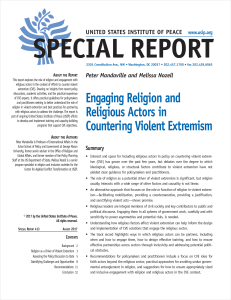 Another vulnerability factor is the legitimacy of political representative. In summing up the dilemma of religious recognition within Lebanon’s modern sectarianism, points to the particular understanding that religious authorities are comparatively an outcome of a somewhat elitist clerical ranking. In this sense, such a particular form of representation can be comprehended as solely appealing to specific institutions more so than their greater communities. This crucial conception aims to convey that this process and system of designation and absence of representation is the rationale behind what creates such a group of non-charismatic leaders, who lack such a popular mandate, as well as authority and influence. This produces segments within particular communities who in turn become quite attracted to informal leaders, who have the power and freedom to maneuver politically, as they are not limited to abide by conditions of mutual interest and interaction with the political class. Over and above, such informal leaders are built on characteristics that are seen as progressive, populist, and radical. In some instances, they are more elevated in scholarly matters, and so further result in a somewhat competition against the formal leaders, while additionally challenging their authority.
Another vulnerability factor is the legitimacy of political representative. In summing up the dilemma of religious recognition within Lebanon’s modern sectarianism, points to the particular understanding that religious authorities are comparatively an outcome of a somewhat elitist clerical ranking. In this sense, such a particular form of representation can be comprehended as solely appealing to specific institutions more so than their greater communities. This crucial conception aims to convey that this process and system of designation and absence of representation is the rationale behind what creates such a group of non-charismatic leaders, who lack such a popular mandate, as well as authority and influence. This produces segments within particular communities who in turn become quite attracted to informal leaders, who have the power and freedom to maneuver politically, as they are not limited to abide by conditions of mutual interest and interaction with the political class. Over and above, such informal leaders are built on characteristics that are seen as progressive, populist, and radical. In some instances, they are more elevated in scholarly matters, and so further result in a somewhat competition against the formal leaders, while additionally challenging their authority.
It is crucial to highlight that the electoral system of religious representation is commonly restricted to the male-influenced elite. Such exclusivity is built on the framework of bureaucrats that more often than not make up the middle or upper level civil workers, such as judges and administrators, among their specific sect’s central clerical regime. Conventionally, religious leaders are seldom to a charismatic disposition, paired with the lack of favored support, yet in some instances contrasting this point may be accurate too.
Religious leaders gained more legitimacy over state institutions during the Syrian war due to the expansion of regional polarisation. They gained trust and confidence through their local communities; thus, the role of formal leaders became ineffective. Such actions supported the rise of informal religious institutions and actors such as the League of Muslim Scholars (Hay’at Al-Ulama Al-Muslimin). The purpose of the League is to fill the vacuum and political opportunity left by Dar Al-Fatwa, but also to oppose Hezbollah interference in the Syrian war. In shedding light on the comparative distinction with Dar Al-Fatwa, the League has gained the capacity to aid and increase its influence in Tripoli. The former league’s chief, Salafi cleric Salem Al-Rafei, along with a number of stronghold Sunnis, portray themselves as the final defenders for the resistance of Tripoli- attempting to indicate the Beirut-based Abdel-Latif Derian’s lack of popularity in the city. Such elements have shown to have impaired Dar Al-Fatwa’s support in the Northern Region of Lebanon, where the establishment has in many instances failed in satisfying their responsibilities. A senior bureaucrat mentioned in late 2014 that the establishment was only capable of administering a third of Tripoli’s mosques, while the remaining were contingent on clerics who were short of any Islamic qualifications, and held close ties to radicals.
The case of Iraq
As mentioned above, the abandonment of the Sunni fighters by the American and the Prime Minister Maliki allowed ISI to become those fighters’ new source of revenue. The tipping point was the waves of Arab uprisings (Kane et al. 2012). Like elsewhere in the Arab MENA, the Sunnis installed sit-in camps in Anbar, Hawija and elsewhere to peacefully protest against Maliki’s divisive and authoritarian policies and his government bad performance. By that time, Maliki managed to strengthen his grip over the military and the state’s institutions following the United States withdrawal from Iraq. The legitimate demands of the protesters were denied, and the sit-in camps were destroyed. In addition to cracking down the Sunni demonstrations, the court, politicized by Maliki, issued warrant arrests against prominent Sunni figures under the pretext of supporting terrorism. Disfranchised by his role, the Sunnis created inceptors for the jihadi groups in the Sunni areas, an attempt to protect themselves from the tyranny of Maliki’s army. Hence, as soon as the Sunni demands were neglected, the black flag of IS (ISIS back then) was seen in the set-in in Anbar.
ISI managed to regroup itself inside Syria, capitalizing on the civil war in the country following the protests in 2011. As soon as the rift between ISI and Al-Nusra front in Syria (Jabhat Fatah al-Sham now), the group began to call itself the Islamic State in Iraq and al-Sham (ISIS). Such discursive exercise of power allowed the group to claim legitimacy over Syria and Iraq. As the flame of the civil war was heating up in Syria, ISIS began to wage attacks against the United States and Iraqi army inside Iraq (Alaaldin 2018). The decisive victory was the occupation of Mosul, the second biggest city in Iraq, in summer 2014 following the control of Fallujah and Ramadi. This incident marked the beginning of a long summer of Sunni discontent. The group declared the establishment of the Islamic State (IS), erasing for the first time the colonial borders between Syria and Iraq in late June 2014 (Hudson 2014). Sceptics about the uncertain situation, thousands of people left the Mosul as soon as IS took control of the city. It is important to mention here that the causes of the mysterious collapse of four Iraqi military divisions remain unrevealed. To fill the man-power dearth and paint the battle against IS with an ideological brush, the Grant Ayatollah Ali Sistani called for Shia Jihad against the Islamic State, which led to the establishment of Popular Mobilization Forces (PMF). Having succeeded in erasing the Sykes-Picot borders between Iraq and Syria for the first time since the establishment of the modern Middle East IS jeopardized the juridical sovereignty of the country. Iraq became to be known as Iraq before Mosul and Iraq after Mosul.
IS was driven out of Mosul in 2017, with the help of the United States-led coalition against IS, the Iraqi army, PMF, and the Kurdish Peshmerga. A few weeks later, the Kurdish President Masoud Barzani declared that Kurdistan region will hold a referendum to ask the opinion of people of Kurdistan about negotiating independence with Baghdad.
The war on IS produced PMF militia, which substituted IS in threatening the central power of the state (Rudolf 2018). Despite the heroic role played by this militia, it has become a challenge to the legitimacy of the government. As of 2017, the militia currently constitutes 60 to 69 factions with a total f of 14,0000 to 15,0000 men. It controls massive areas of Iraq, replacing IS as a non-state actor in the Sunni areas. Mostly importantly, it operates as a peace-keeping force in the Sunni areas. But it has already been accused of committing war crimes under the pretext of fighting terrorism. In addition, the PMU has also been accused of committing social abuses and conducting mafia activities and has also been an obstacle to the return of IDPs. Doing so, it rapidly became a threat to Iraq’s sovereignty, especially that some factions within the PMF are backed by Iran such as Hezbollah Brigades, Asaib Ahl al-Haq, Al-Najbaa, Al-Kharasani, Al-Bodala, Imam Ali, Jund Al-Imam, and Badr (Rwanduzy 2019). Unlike IS, though, PMF is legally part of the Iraqi security apparatus. Members of this armed group dress official uniforms, but they act outside the legal framework of the military regulations. The organisation enjoys $2.16 billion 2018-2019 budget, which is two and half times higher than the budget of the Ministry of Water Resources, three times that of the valiant Counter-Terrorism Service, and 18 times that of the Ministry of Culture. The integration in the state’s security apparatus politicizes the formal army forces in the favour of the Shia community.
The case of Tunisia
Vulnerability factors in Tunisia are caused by internal and external issues. Internally, after 2011, the successive government has been influenced by corruption and the weak political system. While the uncontrolled frontier between the Tunisians’ southern border and Lybia open the road to Tunisians youth to join ISIS.
In fact, the spreading of informal religious institutions after 2011 in Tunisia was translated by: the large increase in the number of associations, the emergence of Islamists political parties, the openness of the country to regional military axes, and the governmental failure to combat corruption. The interaction between state and religious institutions passed from cooptation to a big gap and excessive divide. The number of Koranic schools increased, even without authorization from one hand, the overlapping responsibilities in the large number of ministerial departments in charge of social issues from the other hand. The education system was affected by the new Salafist ideology, for example, some teachers in the Ministry of Education took advantage of their profession to give lessons in religious indoctrination instead of teaching the regular curriculum. Some sports teachers received instructions from imams who were paid by the Ministry of Religious Affairs. Regarding Kindergartens related to the Ministry of Childhood were taught how to dress. This occurred after 2011 when many Salafi instructors returned after having been dismissed during the regime of President Zine El Abidine Ben Ali. The new democratic context permitted citizens to freely discuss their ideological ideas openly, which often led to incompatibility involving teachers who bypassed the objectivity of the official curricula. It has also been noted that 40 percent of the young people open to radicalisation were students or college graduates. Out of 22,634 existing associations in 2019, only 1,685 had transparent accounts, which led to suspicion regarding use of finances in violent extremism.
After 2011, the fragility of the political structure remained unstable. According to the Tunisian officials, transnational fighters volunteered to join ISIS. The presence of a large number of Jihadists in Lybia has created an anxiety for the Tunisians that may cross the borders. Hence, while the country was in the midst of revolutionary turmoil, still hesitating about the new political system to adopt in replacement of the old regime, the Jihadist groups among the extremist Islamist obedience began taking action. The first terrorist attack took place in Rouhia governorates of Siliana in Tunisia [10]. Afterward, terrorist acts multiplied. These comprised the assassinations of political activists, slaughter of soldiers, execution of Anis Jlassi, an officer of the Tunisian National Guard, entrenchment in the Chaambi, Mghira, and Semmama mountains, all of them located in the west of the country, in the governorate of Kasserine. There was also an abortive attempt to establish an Imara (principality) in Ben Guerdane, in southern Tunisia, 33 kilometers from the Libyan border.
To sum up, we identified and analysed the main drivers and factors of vulnerability in interactions between state and religious institutions. This interaction took multiple forms in different countries. The domination with religious institutions over the state institutions is noticed. The interference of religious leaders and institutions formal or informal is visible in different countries. Finally, gaps and missing coordination open the place to extremist ideology and new vision of the world.
The relation between religious institutions and communities is well interpreted by the Law on Churches and Religious Communities in Serbia and BiH where Law legalizes religious institutions. On the other hand, in Lebanon, Iraq, and Tunisia, their constitutions legalize religious institutions and endowments. Financial support to religious institutions increased the tendency to accept their presence without complications. Their role in organizing people’s daily lives bypassed state institutions. Religious institutions penetrated all levels in societies and paved the way to accepting radicalisation and the recruitment of extremists to fight abroad. Ethnic or sectarian division in communities, the role of non-governmental organisations, tax exemptions for religious institutions, poor governance, failure of the rule of law increased the tendency to have confidence in religious institutions as a source of resilience, since they operate on all levels in the society. This resilience will be studied in the following part in cooptation interactions between state and religious institutions and actors related to violent extremism in different contexts.
In the developing countries, violent extremism is increasing due to several factors such as fall of regimes, injustice, human rights violations, poor governance, social political exclusion, and corruption. Some of the factors that encouraged men and women to join extremist groups are the absence of the state, fragility of state institutions, lack of rule of law, and the predominant institutional anomie which intensified the feeling of victimisation in an unjust state. The post-war period and crisis in Serbia, Bosnia and Herzegovina, Lebanon, Tunisia, and Iraq strengthened those factors and influenced radicalisation and violent extremism. The countries lost the ability and power to administer their institutions and societies, which impacted on the growth of radicalisation.
States share common political vulnerabilities such as: polarisation of state identity in which each religious or ethnic group has its own expectation from the state. Often, communities experience the abuse of political power and the denial of political rights and civil liberties resulting in the mistrust in the state institutions. The power sharing between state and religious institutions in Lebanon, Iraq and Tunisia and between state institutions and ethnic groups in Serbia and Bosnia and Herzegovina has led to dysfunctional justice. In addition, the communities share common vulnerabilities in social and economic development due to the absence and fragility of state institutions. Lack of a unified educational system and equal access contributed to increasing violent extremism and radicalisation especially among the marginalized area and groups. The five countries have become less effective in meeting the expectations of their citizens. The dysfunctional relationship between state and religious institutions and porosity gained credibility over state institutions.
Dialoghi Mediterranei, n. 61, Maggio 2023
[*] Abstract
Il paper ha identificato e analizzato i principali elementi e fattori di vulnerabilità nelle interazioni tra istituzioni statali e religiose in Serbia, Bosnia-Erzegovina, Libano, Iraq e Tunisia. Questa interazione ha assunto molteplici forme in diversi Paesi. Si nota il predominio delle istituzioni religiose su quelle statali e l’ingerenza dei leader religiosi e delle istituzioni formali o informali assai visibile in molti Paesi. Infine, i divari e il mancato coordinamento aprono spazi all’ideologia estremista e a nuove prospettive nel mondo. La divisione etnica o settaria nelle comunità, il ruolo delle organizzazioni non governative, le esenzioni fiscali per le istituzioni religiose, il cattivo governo, il fallimento dello stato di diritto hanno aumentato la tendenza ad avere fiducia nelle istituzioni religiose come fonte di resilienza, dal momento che operano su tutti i livelli della società.
La ricerca che ha portato a questi risultati ha ricevuto finanziamenti dal programma di ricerca e innovazione Orizzonte 2020 dell’Unione europea nell’ambito della convenzione di sovvenzione n. 870769. Questo lavoro si basa sulla collaborazione tra il coordinamento dei Paesi nel progetto WP4 H2020 PAVE.
Note
[1] For more information, see the Serbian Constitution https://www.ilo.org/dyn/natlex/docs/ELECTRONIC/74694/119555/F838981147/SRB74694% 20Eng.pdf
[2] For more information on ICoS, see https://www.rijaset.rs/index.php/rijaset.
[3] For more information on the Constitution of Bosnia and Herzegovina, see https://www.wipo.int/edocs/lexdocs/laws/en/ba/ba020en.pdf.
[4] For more information on this issue, see BiH International Religious Freedom Report (online: https://ba.usembassy.gov/wp-content/uploads/sites/270/2018_BIH_IRF_Report_BOS.pdf), (2018)
[5] In the foreword to the book “Crkva i država u BiH” (Church and State in BiH), Tomo Vukšić underscores that «the great novelty and result of the aforementioned legislation consist primarily in the fact that religious communities and their numerous institutions, which have in formal terms been outside the law before this legislation, have acquired legal subjectivity in the state law and have been placed under public law. This ensures that each of them can, as a recognised legal entity under public law, claim their rights and agree and regulate matters with the state as a legally recognised legal entity in the society and a formal partner to the state government» (Source: https://www.bkbih.ba/info.php?id=6).
[6] Therefore, Bosniaks, Croats and Serbs are defined as constituent peoples that participate in the executive and the legislative branches. For example, Article V of the Constitution of BiH reads: «The Presidency of Bosnia and Herzegovina shall consist of three Members: one Bosniac and one Croat, each directly elected from the territory of the Federation, and one Serb directly elected from the territory of the Republika Srpska». This discriminatory provision made it impossible for citizens who do not belong or do not feel that they belong to one of the three ethnic groups.
[7] For more information, see https://www.srbijadanas.com/clanak/ko-su-pravoslavni-ziloti-12-08-2014.
[8] For more information, see The Lebanese Constitution. Presidency.gov.lb. 1926. Retrieved 9 July 2020, from http://www.presidency.gov.lb/Arabic/LebaneseSystem/Documents/
[9] Ibid.
[10] Following that terrorist act, two perpetrators were killed as well as two soldiers and another one seriousl injured.
References
Al-Haddad, G. 2015. “Financial Tax and Sectarianism in Lebanon”. Legal agenda. Retrieved 11 July 2020, from https://www.legal-agenda.com/article.php?id=1221.
Al-Sayyed, R. 2018. Religious Institutions and the Challenges of Extremism and Terrorism: The Long View. Retrieved 24 June 2020
https://www.berghoffoundation.org/fileadmin/redaktion/Publications/Handbook/Dialogue_
Chapters/dialogue13_violentextremism_elsayed_com.pdf.
Alaaldin, R. (2018). Sectarianism, Governance, and Iraq’s Future. Brooking Doha Center AnalysisPaper, 24.
Beridan, I., Smajić, M. and Turčalo, S. 2018. “(Geo) politički i sigurnosni izazovi demokratskoj konsolidaciji tranzicijskih država: slučaj Bosne i Hercegovine”. Forum za sigurnosne studije, 2 (2): 153-154. https://hrcak.srce.hr/210720.
Ćorović, A. 2017. “Radicalization in Serbia: The Youth of Sandžak between a Hammer and an Anvil.” Between Salvation and Terror: Radicalization and the Foreign Fighter Phenomenon in the Western Balkans. Azinović, Vlado (ed.): 125–136. Sarajevo: The Atlantic Initiative
Ellis, H. and Abdi S. (2017). ‘Building Community Resilience to Violent Extremism through Genuine Partnerships’, American Psychologist, 72(3): 289-300.
Hudson, D. (2014). President Obama: “We Will Degrade and Ultimately Destroy ISIL”. The WhileHouse Blog, 10 September. Available at https://obamawhitehouse.archives.gov/blog/2014/09/10/president-Obama-we-will-degrade-and-ultimately-destroy-isil.
Ilić, V. 2016. Koliko su mladi otvoreni prema islamskom terorizmu. Belgrade: Helsinki Committee for Human Rights.
Jusić, M. 2017. “The Complex Ecology of Islamic Narrative and Movements in Bosnia and Herzegovina” in Azinović Vlado (ed.), Between Salvation and Terror: Radicalisation and the Foreign Fighter Phenomenon in the Western Balkans, School of Political Sciences, University of Sarajevo.
Kane, S., Hiltermann, J. R. and Alkadiri, R. (2012). Iraq’s Federalism Quandary.The NationalInterest, 28 February. Available at http://nationalinterest.org/article/iraqs-federalismquandary-6512.
Kisić, I. 2015. “The Role of the Civil Society in Countering Violent Extremism”. Ejdus, Filip and Predrag Jureković (eds.). 2015. Violent Extremism in the Western Balkans, 163-178. Belgrade: Regional Stability in South East Europe Study group.
Kladničanin, F. 2013. “Vehabije u sajber prostoru.” Jelinčić, Jadranka and Snezana Ilic eds. Politicki Ekstremizam u Cyber Prostoru Srbije: 127-134. Zrenjanin: Centar za Razvoj Civilnog Društva.
Lefèvre, R. 2015. Lebanon’s Dar al-Fatwa and the Search for Moderation. Carnegie Middle East Center. Retrieved 24 June 2020. https://carnegie-mec.org/2015/01/05/lebanon-s-dar-al-fatwa-and-search-for-moderation-pub-57627.
Mandaville, P. and Melissa, Nozell (2017). Engaging Religion and Religious Actors in Countering Violent Extremism. Special Report 413. USIP
NOW Lebanon. 2011. Hezbollah delegation visits Grand Mufti, November 28. http://www.nowlebanon.com/NewsArticleDetails.aspx?ID=337113 (Accessed November 28, 2011).
Perry, V. 2019. “Defining, Framing and Contextualizing Extremism and Violent Extremism in Serbia: An Introduction to the Volume”. Extremism and Violent Extremism in Serbia, Perry, Valery (ed.): 8-70. Ibidem Press/Columbia University Press.
Rudolf, I. (2018). Holy Mobilisation: The Religious Legitimation behind Iraq’s Counter-ISISCampaign. London: Trends Research Advisory and International Centre for the Study of Radicalisaion.
Rwanduzy, M. (2019). Iraqi PM decrees full integration of PMF into Iraqi forces. Rûdaw, 1 July.Available at https://www.rudaw.net/english/middleeast/iraq/01072019
The Daily Star. 2010. Qabbani meets with Iran’s new ambassador. The Daily Star Newspaper-Lebanon. Retrieved 27 July 2020. https://www.dailystar.com.lb/News/Lebanon-News/2010/Jun-04/57477-qabbani-meets-with-irans-new-ambassador.ashx.
The Lebanese Constitution. 1926. Retrieved 9 July 2020. http://www.presidency.gov.lb/Arabic/LebaneseSystem/Documents/
Turčalo, S. & Nejra, V. 2018. Community perspectives on the prevention of violent extremism in Bosnia and Herzegovina, Atlantic Initiative, Berghof Foundation: Berlin.
YaLibnan. 2016. “Lebanon Patriarch and Hezbollah Chief Met to Discuss Presidential Vacuum,” May 4, http://yalibnan.com/2016/05/04/lebanon-patriarch-and-hezbollah-chief-met-to-discuss-presidential-vacuum.
_____________________________________________________________
Marie Kortam, docente di sociologia all’Università di Beirut, presso il dipartimento di Storia contemporanea, ha conseguito il dottorato di ricerca all’università di Parigi. Membro del Consiglio arabo per le scienze sociali, collabora a numerosi progetti di ricerca sulle relazioni civili-militari. Ta i suoi interessi scientifici: la violenza e i movimenti sociali, i processi di radicalizzazione politica e l’organizzazione dei gruppi islamisti. Tra le sue ultime pubblicazioni si segnalano: Fighting terrorism and radicalisation in Europe’s neighbourhood: Discours Sur la Violence (Univ. Europeenne, 2018); How to scale up EU efforts; Jeunes du Centre, Jeunes de la Peripherie (2018).
______________________________________________________________



